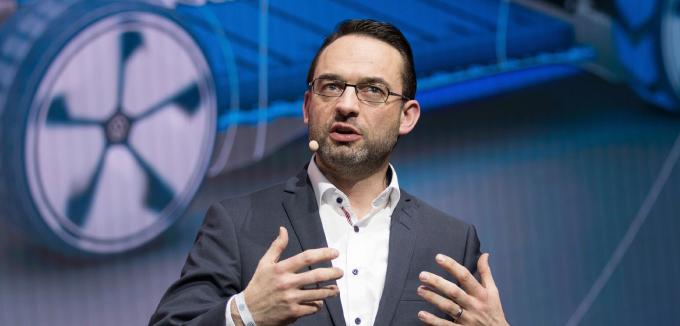Invest
Electric Cars
Electric Car Benefits
Electric Car Sales
Solar Energy Rocks
RSS
Advertise
Privacy Policy
Autonomous Vehicles
Published on June 18th, 2019 |
by Guest Contributor
Automotive Design: Tesla & Other Carmakers Plan For “ACES” In The Future
Twitter
LinkedIn
Facebook
June 18th, 2019 by Guest Contributor
Originally posted on EVANNEX.
By Charles Morris
The automobile has always been a very dynamic product. Since cars came into widespread use in the early 20the century, almost everything about them has been constantly (albeit slowly) changing. Over the decades, vehicles have become more reliable, more powerful, and more efficient; and a continuous stream of new features has made them more comfortable (AC, adjustable seats), more convenient (keyless entry, cruise control, GPS), and safer (from seat belts to airbags to collision-avoidance systems).
Image credit: JRR
Meanwhile, the appearance of our cars has gone through many phases, driven less by technical requirements than by shifting fashions. Most of us can guess which decade a movie was set in by looking at the cars, from the big boxy tourers of the 1920s to the rounded contours of the 1940s to the tail fins of the 1950s to the sleek sedans of the 1980s to today’s SUVs (which arguably are beginning to look a lot like those boxy tourers).
Much more change is coming, and it’s going to unfold much more quickly than ever before, thanks to a quartet of technological trends that some are now referring to as ACES (autonomous, connected, electric, shared). Tesla has been at the forefront of the first three of these developments, and intends to be a major player in the fourth as well.
In a recent article in The Conversation, entitled “Cars will change more in the next decade than they have in the past century,” Dan Lewis, Claude C. Chibelushi and Debi Roberts take a look at some of the innovations that are coming down the road.
Some changes will be cosmetic. The air intakes and grills that have long defined some brands’ signature looks will disappear, as electric powertrains don’t need them (Teslas never had them). Side rearview mirrors (wing mirrors across the pond) are also slated for extinction, thanks to improved camera technology and the need for better aerodynamics. (Tesla wanted to eliminate side mirrors on the Model X, but regulators wouldn’t allow it. Some European versions of the new Audi e-tron are spiegellos.)
Other changes will be much more fundamental — the advent of autonomy and new ownership models will gradually change the basic concept of what an automobile is. The article in The Conversation predicts that, once humans don’t need to drive, windows could be adjustable in size — larger for better views (a la Tesla’s glass roofs), non-existent for naps. Cars could even have flexible layouts, able to be configured as a mobile office, a bedroom, or a cargo carrier. Volvo’s 360c concept car presents one vision of this future.
The way we control our cars is evolving quickly, and the end result could be that they become like extensions of our human bodies. Augmented-reality systems will provide more and more information about a vehicle’s surroundings, and voice commands could someday develop into direct brain-to-computer interfaces, allowing occupants to control vehicles with pure thought. Cars will also communicate with various smart city features, from traffic signals to charging facilities to multimodal public transport.
Volvo’s 360c concept car could tease a few features we might see in future cars. (YouTube: The Tech Chap)
Alongside the technological trends of ACES, business and political shifts are changing the makeup of the auto industry. Tomorrow’s configurable, self-driving electric cars may very well be designed in China or Germany, not Michigan (that is, unless the legacy US automakers start raising their games very soon). The Conversation speculates that tomorrow’s drivers (riders?) might not be riding in a Ford, a Chevy, or a Beemer; but in a Tesla, a Dyson, an Apple iCar, or a Google.
About the Author
Guest Contributor is many, many people. We publish a number of guest posts from experts in a large variety of fields. This is our contributor account for those special people. 😀
Back to Top ↑
Intern OpportunitiesWe Need You! Internship Program Openings
Advertisement
Advertise with CleanTechnica to get your company in front of millions of monthly readers.
CleanTechnica Clothing & Cups
Top News On CleanTechnica
Join CleanTechnica Today!
Advertisement
Advertisement
Follow CleanTechnica Follow @cleantechnica
Our Electric Car Driver Report
Read & share our new report on “electric car drivers, what they desire, and what the demand.”
The EV Safety Advantage
Read & share our free report on EV safety, “The EV Safety Advantage.”
EV Charging Guidelines for Cities
Share our free report on EV charging guidelines for cities, “Electric Vehicle Charging Infrastructure: Guidelines For Cities.”
30 Electric Car Benefits
Our Electric Vehicle Reviews
Tesla News
Cleantech Press Releases
Hannon Armstrong & Summit Ridge To Jointly Invest In Community Solar; Initial Projects Launching in Maryland
“That Was Quick” Category: Carbon Engineering Partners With Occidental To Pump More Oil
Texas Cooperatives Agree to Purchase 7 MW of Distribution-Scale Solar Energy
38 Anti-Cleantech Myths
Wind & Solar Prices Beat Fossils
Cost of Solar Panels Collapses
© 2018 Sustainable Enterprises Media, Inc.
Invest
Electric Cars
Electric Car Benefits
Electric Car Sales
Solar Energy Rocks
RSS
Advertise
Privacy Policy
This site uses cookies: Find out more.Okay, thanks


